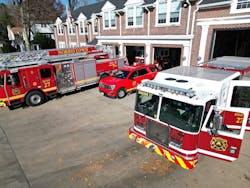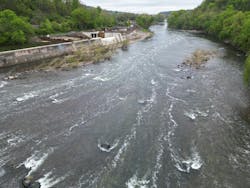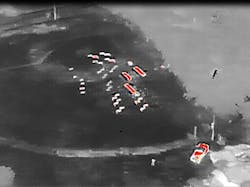For a while now, drones have been popping up all over the place. Fire departments both large and small made the investment and started their own drone program. That said, does your department need one?
I was the guy in my department who first said, “This will be cool to have.” I read articles and books and talked to anyone who had experience to learn as much as possible. I eventually got my own drone and Part 107 Certificate. I even got a chance to see firsthand how useful a drone can be during several search operations. I immediately knew that my department could do so much with one.
Most of the members of my department knew that I was interested in drones. They weren’t surprised when I started to ask their feelings about the devices and to gauge their interest. Some of them believed that drones were becoming the new toy or fad. Some of the members were concerned that getting a drone without a plan on how or when to use it would lead to the failure of such a program.
I took their thoughts, both the positive and, more importantly, the negative, and did more research and networking. I quickly found that my coworkers weren’t the only ones who had those concerns. Furthermore, I thought about whether our department needed a $50,000 drone for it to only sit in the basement and collect dust. What if only one person was able to fly it and that person wasn’t available when the drone was needed?
Time well spent
If you believe that your department could benefit from starting a drone program, don’t be discouraged if you get a negative response from leadership when you raise the matter. It’s their responsibility to ensure that the department is fiscally responsible. Instead, hear them out. Listen to their concerns (write them down). Work to understand their reluctance and then do the research. Check online blogs and talk to other organizations, to be more than prepared the next time that you have the conversation. Then, even if the conversation doesn’t result in your department starting a drone program, you might get leadership thinking about drones from a different perspective.
There are apparent uses for a drone, and many articles talk about them: overwatch, reconnaissance, searches, mapping, etc. However, I noticed that few people talk about the challenges or concerns that departments have.
Below are some of the concerns that I have heard—and had myself—and my thoughts on them.
They cost too much
This isn’t 100 percent true. You can get a drone for less than $250. True, that drone might not have a long flight time, a thermal camera or other capabilities that expensive models have, but it might be what your department needs.
My department used a small drone to assess a building that was condemned. From the ground, we couldn’t see the status of the roof or part of the back of the building. Using the drone, we could easily see that the roof was compromised. The chief was impressed with the images that I got, that we didn’t have to shut down the road to use the aerial ladder (which really only would offer a limited view of the structure) and that no member was put at any unnecessary risk. The drone that we used that day cost about $400 and was exactly what was needed.
Who can conduct training?
There are plenty of online training resources. Some are free. I ordered a book from Amazon and found videos on YouTube to prepare for my Part 107 test.
I spent less than $60 to prepare for the test and came away with all of the general knowledge that I needed.
Later, I took certification training and testing for NFPA 2400: Standard for Small Unmanned Aircraft Systems (sUAS) Used for Public Safety Operation through the Delaware state fire academy. Although it wasn’t required, it provided a chance to build on my skills and network with other pilots.
The NFPA 2400 course also discussed some of the best practices for our industry, but networking with other drone operators was one of the most beneficial parts of the course. I got a chance to speak with pilots about real-world experiences. That was vital to my development as an operator. I also got a chance to demo some of the latest drones. You don’t need to spend $14,000 and spend six weeks in a training academy, when local organizations are willing to mentor and provide good information, including their successes and failures.
Other organizations and sectors that use drones that you should consider contacting are:
- Police departments
- Search and rescue
- Department of Transportation
- Construction/demolition contractors
- Real estate
Everyone has one. Why do we need one?
This is a common discussion point: State, county and other local resources could do the job. This falls in the same realm as not every fire station needs a 100-foot tower ladder, but you know who to call when you need one.
You can help your department to identify drone resources and understand their capabilities. You can also find out how to request them. This is essential information that my leadership was really receptive to.
All that said, yes, you can call the county and request a drone, but is it necessarily the right kind that you need?
I spoke with the leadership of my department about the different types of drones, deployment times and information that most pilots need to better prepare for a mission. For example, a local police department tries to have one drone in a car available at all times. The drone can be brought to a scene and be in the air quickly, but if the drone doesn’t have a thermal camera to check for hot spots—let’s say that it’s utilized by the police for indoor use during tactical operations—it would be the wrong tool for the job.
The drone will sit and collect dust
This can happen if you jump on a purchase without a plan, lack complete buy-in from your leadership or fail to do all of the research. You don’t want to get a drone that no one can fly or is the wrong drone for your department.
They require a lot of maintenance and upkeep
So do all of the apparatus and equipment that departments buy. As with apparatus, you should perform regular maintenance (check batteries, propellers and software) and identify needs and resources, such as maintenance providers, before you make a purchase.
I know all I need to know, or it isn’t my problem
Yes, these are ways that one can think about it. After all, if you don’t have a drone, you don’t need to spend time to educate yourself about them.
My response: Did you ever consider how a citizen who has a drone could disrupt an operation? Understanding how a drone could be helpful to the department is only part of the matter. Understanding the limitations, downfalls and legal implications should also be on the mind of everyone at the department.
Can you legally force nonpublic safety drones out of the sky or from operating over a fire scene? What’s your plan for dealing with nonpublic safety drones?
From my research, including talking to other organizations, you must be very careful about dealing with them, such as trying to knock a drone out of the sky. The Federal Aviation Administration regulates drones, and the same laws that apply to other types of aircraft apply to drones. So, if you wouldn’t direct a hose stream at an overhead helicopter to shoo it away, you shouldn’t do that to a drone.
Inform your leadership on how to get a temporary no-fly zone over an operation. Work with police to check the area to see whether the pilot can be identified and let law enforcement handle it. In our area, we can call our communications center, and those folks can quickly request a no-fly zone as long as it meets specific criteria. It’s a good idea to know the criteria before you need it.
Do we need a warrant?
I am not a lawyer, so ask one for his/her opinion before you start a drone program. Numerous factors determine when you would need one. You should have a basic understanding, because this question will be asked.
The bottom line
Become the department expert that leadership doesn’t know it needs.
Stay current on the latest information and return it to your department.
Reach out and network with other organizations and maintain a working relationship with them.
Listen to and understand your department’s concerns and provide guidance.
If your department decides that it’s ready to talk about drones, be open-minded, honest and helpful. If investing in a drone isn’t suitable now, you can help by ensuring that the right one is available (mutual aid) if and when it’s needed.
About the Author

Charles Scott
Charles Scott has been a member of the Norristown, PA, Fire Department (NFD) since 2007 and was hired full-time in 2018. He currently is a firefighter who is assigned to the A platoon. Scott also is one of the department’s eight UAV pilots and was part of the development and implementation of the NFD’s drone program. In addition, Scott conducts medical and CPR training for the department and community organizations.




